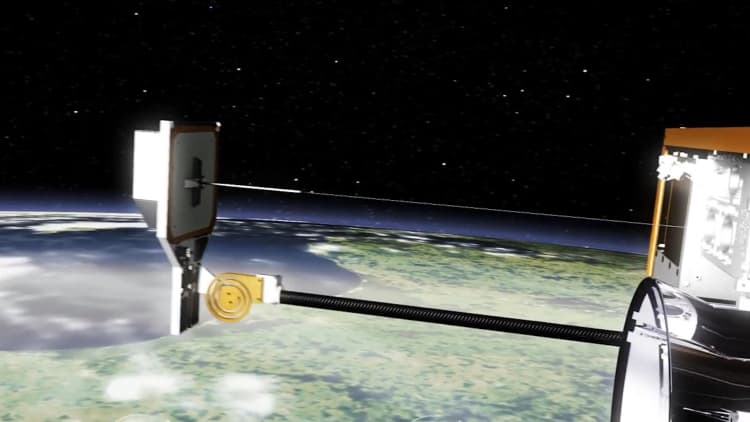
Space debris has become a huge problem. Their accumulation in Earth's orbit has become a hindrance and can endanger future missions to the moon or Mars, according to the chief of a company that's trying to solve the issue.
A surge in aggressive space ventures in recent years has seen a build-up of space junk, and they are set to grow exponentially, Nobu Okada, founder and CEO of Astroscale, told CNBC at the World Economic Forum's Annual Meeting of the New Champions in Tianjin, China.
"Over the last 5 to 7 years, we saw (about) 2,000 space ventures in the world. Their plans are so aggressive, they're going to launch 10,000 to 20,000 satellites over the next 5 to 10 years," he said. "We see the exponential growth of objects in space."
There are more than 500,000 pieces of junk floating around Earth's orbit, including defunct satellites, rocket boosters, nuts and bolts, all of which pose a substantial threat to astronauts and spacecraft, according to U.S. space agency NASA. The European Space Agency said that as of January 2018, there are about 29,000 objects larger than 10 centimeters, around 750,000 objects that range between 1 cm to 10 cm and about 166 million objects between 1 millimeter to 1 cm in size.
Okada said that pieces of debris fly around the Earth throughout the day, and there are plenty of near-miss situations where two objects almost collide. When they do hit each other, those collisions end up creating even more debris.
"Even the small particle caused by the collision has enough power to blow up a satellite," he said. "If we continue the chain reactions of the collisions, we won't be able to put our space assets into space. So it's now (that) we have to remove large objects from space."
There are objects in orbit that move at about 8 kilometers a second which means, potentially, debris the size of a marble can be devastating to a satellite, David Ball, CEO of Australia-based Space Environment Research Center, told CNBC in August.
Okada said his company is developing technology that can go up to orbit to identify large objects that pose a threat to spacecraft and bring them down to the atmosphere to burn. While the projected cost of removing debris is somewhere between $100 million to $500 million for a single removal, according to Okada, Astroscale is trying to significantly lower that cost.
But Astroscale isn't the only company that's looking at ways to clean up space debris. The University of Surrey Space Centre already has a spacecraft in orbit, with debris-removing technologies such as a harpoon, a net and a drag sail, to carry out experiments, according to reports.
One particular challenge lies in being able to accurately detect the smaller pieces of debris that also pose significant threats. The Space Environment Research Center was studying ways to accurately identify smaller objects in orbit and alert satellite operators, Ball told CNBC.
The debris has actually made a "debris zone around the sphere," Okada said. "When we go to the moon, or Mars, we have to go through this debris band. To securely bring something to the moon and Mars, we have to clean up the space debris."
WATCH: This harpoon could solve Earth's space junk problem



